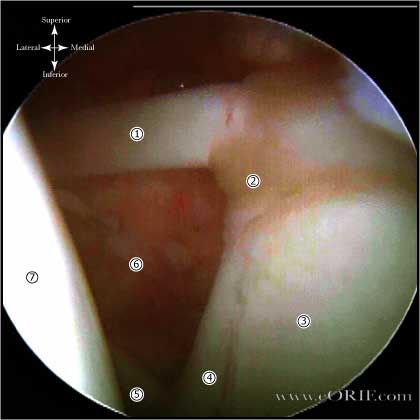|


|
synonyms:biceps tenodesis
Biceps Tenodesis CPT
Biceps Tenodesis Appicable ICD-10 Codes
- M66.821 - Spontaneous rupture of other tendons, right upper arm
- M66.822 - Spontaneous rupture of other tendons, left upper arm
- M66.829 - Spontaneous rupture of other tendons, unspecified upper arm
- M75.20 - Bicipital tendinitis, unspecified shoulder
- M75.21 - Bicipital tendinitis, right shoulder
- M75.22 - Bicipital tendinitis, left shoulder
Biceps Tenodesis Indications
- Biceps tendonitis in a younger, physically active patient.
- Long head of biceps tendon rupture in a young, physically active patient.
- Long head of biceps tendon rupture with significant cosmetic concerns.
- Subluxation of biceps tendon out of the bicipital groove.
- Partial thickness fraying of the biceps tendon.
Biceps Tenodesis Contraindications
- Elderly low demand patients
Biceps Tenodesis Alternatives
- Biceps Tenotomy
CPT: 23405 (tenotomy, shoulder area; single tendon)
Intraarticular release of the long head of the biceps tendon.
Typically used for elderly patients with low physical demands
Patients may develop cosmetic deformity (Popeye muscle) post-operatively.
Quicker recovery and earlier return to function than arthrodesis.
- Non-operative management
Biceps Tenodesis Pre-op Planning / Special Considerations
- Percutaneous Intra-articular Trans-tendon technique: (Sekiya JK, Arthroscopy 2003;19:1137). Easily performed and does not require any supplemental hardware.Other techniques include: suture anchors, screw and soft tissue washer, keyhole technique.Arm postion for biceps tenodensis = 30 degrees flexion, 30 degrees IR, 30 degrees abduction. Elbow flexed to 90 degrees.
Biceps Tenodesis Technique
- Arthroscopic tenodesis with absorbable interference screw (Boileau Arthroscopy 2002:18:1002-1012)
- Pre-operative antibiotics, +/- regional block
- General endotracheal anesthesia
- position. All bony prominences well padded.
- Examination under anesthesia.
- Prep and drape in standard sterile fashion.
- Perform Shoulder Arthroscopy.
- Place tag suture into long head of biceps tendon using anterior medial and Anterosuperolateral portals.
- Perform tenotomy of the tendon at is BLC insertion using an arthrscopic biter, or hooked cautery probe.
- Extend anteriosuperolateral portal into a 2-3cm longitudinal incision over the bicipital groove.
- Split deltoid fibers.
- Pull tendon into view using tag suture. Ensure suture is well fixed in tendon.
- Excise any osteophytes in bicipital groove and roughen distal groove.
- Place ACL guide wire / beath pin centered in the mid to distal bicipital groove. Pin will exit posterior humeral head, coming out the posterior skin, near the previous posterior portal. Ensure pin is not aimed distally to avoid axillary nerve injury.
- Drill 7-mm hole in the distal end of the groove 20mm deep.
- Place passing suture into the eyed hole of the ACL guide wire and pull pin into the drill hole, pulling passing wires out posterioly.
- Arm postioned for biceps tenodensis (30 degrees flexion, 30 degrees IR, 30 degrees abduction. Elbow flexed to 90 degrees).
- Tendon drawn into drill hole, tensioned with passing suture and then secured with 7mm by 20mm bioabsorbable interference screw.
- Irrigate.
- Close in layers.
Biceps Tenodesis Complications
- Failure with cosmetic deformityy (Popeye deformity)
- Infection
- Stiffness
- CRPS
Biceps Tenodesis Follow-up care
- Post-op: sling, immediate passive elbow and shoulder ROM, pendulum exercises, active wrist/hand ROM.
- 7-10 days: Continue sling. Started PT. Begin active shoulder motion without resistance. Avoid any resisted active elbow flexion / supination.
- 6 weeks: start muscle strengthening, active elbow flexion / supination.
- 3-6 months: Return to sporting activites.
Biceps Tenodesis Outcomes
Biceps Tenodesis Review References
|


